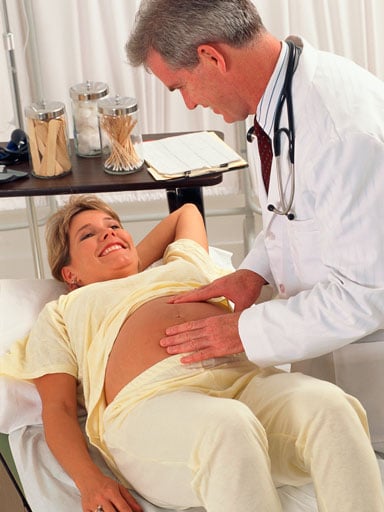 A pregnant patient is examined by a physician.
A pregnant patient is examined by a physician.
A recent study by the University of Colorado School of Medicine (SOM) looked at whether pregnant patients experienced a higher risk of post-surgical adverse outcomes and death than non-pregnant patients with comparable risk profiles.
Robert Meguid, MD, MPH, FACS, Assistant Professor of thoracic surgery and director of SOM's Surgical Outcomes and Applied Research (SOAR), led the study, which was published last May in the Journal of the American Medical Association—Surgery.
"One of the residents in our department and I were talking about the risk of complications with pregnant patients and the attendant anxiety for surgeons as well as the patients themselves," Meguid said. He noted that, out of the entire population of patients who undergo surgery, there is a higher proportion of pregnant patients who undergo emergency surgery. This is because surgeons typically refrain from elective procedures until after childbirth.
The subject of surgical outcomes in pregnant patients carried added significance for Meguid because, at the time of the study, his wife was pregnant.
His team's broad study of patients was possible because the University of Colorado Hospital and the Department of Surgery recently began participating in the National Surgical Quality Improvement Program (NSQIP), which offers access to a national database of about 3 million patient records. In the literature on previous studies, the researchers found conflicting information about adverse outcomes after surgery for pregnant patients.
 A pregnant patient is examined by a physician.
A pregnant patient is examined by a physician.
Past studies had mainly focused on appendectomies and cholecystectomies (gallbladder removal), both fairly common surgical procedures done on pregnant patients. "We thought that there are a lot of other operations that carry higher risks on pregnant women — thoracic and trauma incidents (vehicular accidents, penetrating injuries, etc.) — let's look at those patients, as well as those who had been previously studied," Meguid said.
In the national database, Meguid's team found about 2,700 pregnant patients who'd undergone a variety of surgical procedures. They found over 500,000 non-pregnant patients who underwent the same types of operations. The researchers used propensity matching to ensure they were comparing patients — pregnant and non-pregnant — with comparable risk profiles.
"We found that pregnant patients thankfully, but surprisingly, didn't have a higher risk of adverse outcomes and death than the non-pregnant population," Meguid said. "We think that physicians are approaching pregnant patients with an even higher degree of care and diligence, and probably enlist more resources to bear on the patients to make sure they do well."
Despite the reassuring findings, Meguid said he wouldn't advise that pregnant patients have elective surgery. Physicians still don't yet know the short- or long-term outcomes on the child after surgical procedures, he said.
The SOM team presented their findings at a NSQIP conference this summer. Meguid said the team talked with other surgeons about the possibilities of future research, including a multi-health center study of fetal outcomes of pregnant patients who'd undergone surgery. Such data would provide a more comprehensive picture of the effects of surgery on pregnant patients and their children.
For now, Meguid is pleased to know that care is at a high level. "It's reassuring that, as a surgeon who takes care of the occasional pregnant patient, the acuity with which we approach that patient is in keeping with the standard of care for non-pregnant patients," he said.
Co-authors of the study are: Hunter B. Moore, MD (1); Elizabeth Juarez-Colunga, PhD (2,3,4); Michael Bronsert, PhD, MS (2,3); Karl E. Hammermeister, MD (2,3,5); William G. Henderson, MPH, PhD (2,3,4); Ernest E. Moore, MD (1,6); Robert A. Meguid, MD, MPH (1,2)
1 - Department of Surgery, School of Medicine, University of Colorado, Aurora
2 - Surgical Outcomes and Applied Research Program, School of Medicine, University of Colorado, Aurora
3 - Adult and Child Center for Health Outcomes Research and Delivery Science, School of Medicine, University of Colorado, Aurora
4 - Department of Biostatistics and Informatics, Colorado School of Public Health, Aurora
5 - Division of Cardiology, Department of Medicine, School of Medicine, University of Colorado, Aurora
6 - Department of Surgery, Denver Health Medical Center, Denver
